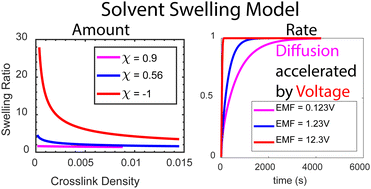Modeling dynamic swelling of polymer-based artificial muscles†
Abstract
Polymer-based artificial muscles are lightweight, are flexible, can have variable stiffness, and provide actuation in applications in which heavy actuators are not feasible. Achieving device requirements, such as strain, strain rate, lifetime, achievable work, and efficiency, requires material and muscle geometry design. This study is motivated by the possibility of significant actuation from twisted and coiled polymer (TCP) fibers that rely on radial swelling to produce reversible work. Modeling the actuation of advanced polymers is essential for defining design metrics. An analytical thermodynamic expression based on Flory–Rehner Theory was combined with a numerical transport model in order to simulate transient swelling of a polymeric network driven by diffusion and migration. Radial swelling of polymer fibers was modeled, including parametric studies and comparison to experimental data. By increasing the transport distance, swelling is shown to increase the time to equilibrium, but this can be more than compensated by applying voltage to take advantage of ion migration/electroosmotic drag. This work indicates that, in addition to migration, dimensions smaller than 100 micrometers here are needed to achieve the sub-second response times of natural muscles. The impact of polymer swelling on transport in polymers is directly evaluated by locally accounting for the length increase of discrete elements due to solvent presence, which cannot be done analytically. Furthermore, strain and work done by swelling a TCP is modelled, and the benefit of anisotropic swelling and constant modulus is quantified.



 Please wait while we load your content...
Please wait while we load your content...